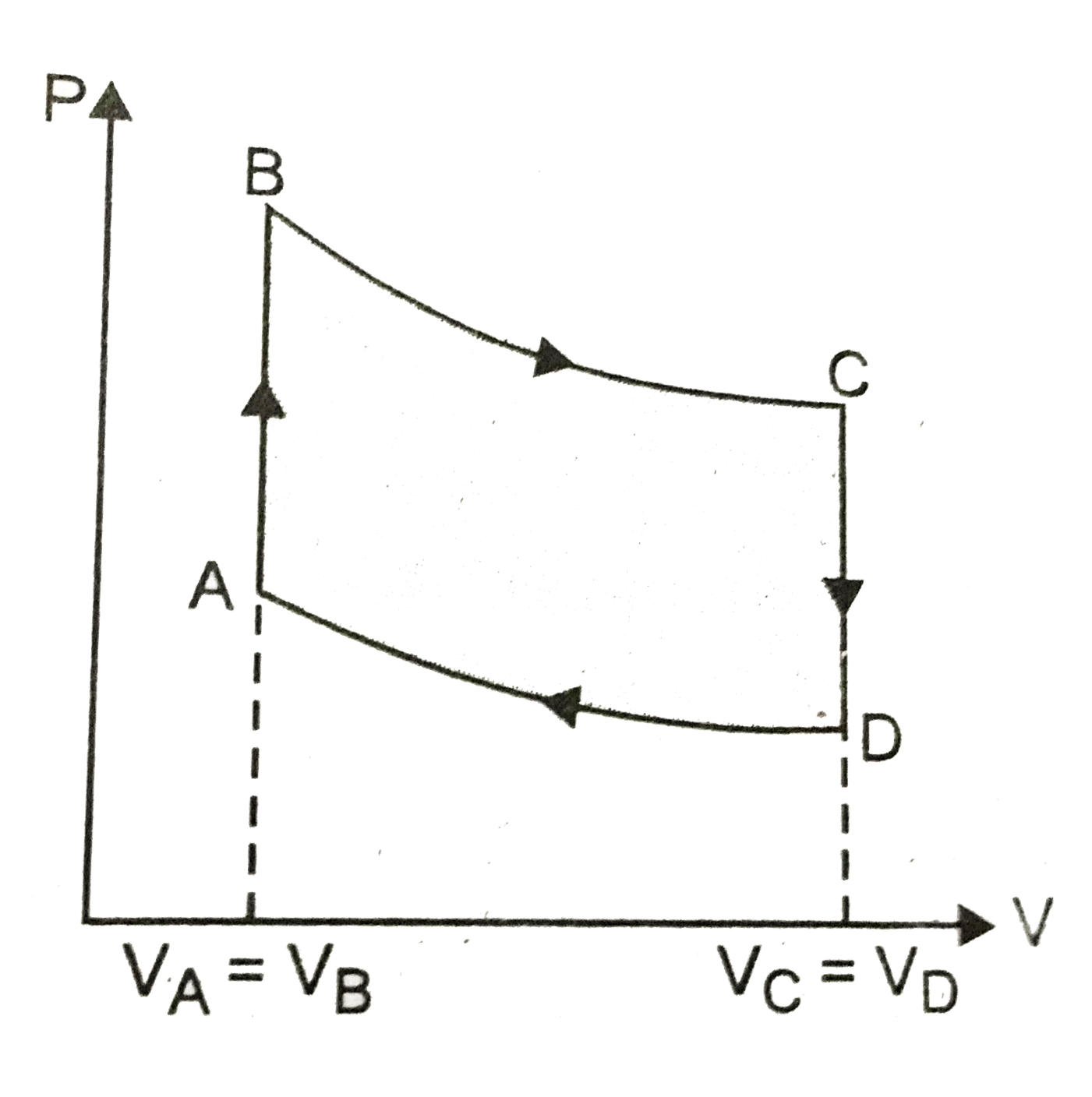A cycle followed by an engine (made of one mole of an ideal gas in a cyclinder with a piston) is shown in (figure). Find heat exchanged by the engine, with the surrounding for each section of the cycle. [CV=(3/2)R]
AB : constant volume BC : constant pressure
CD : adiabatic DA : constant pressure.
![A cycle followed by an engine (made of one mole of an ideal gas in a cyclinder with a piston) is shown in (figure). Find heat exchanged by the engine, with the surrounding for each section of the cycle. [C(V)= (3//2)R] AB : constant volume BC : constant pressure CD : adiabatic DA : constant pressure.](https://d10lpgp6xz60nq.cloudfront.net/physics_images/PR_XI_V02_C08_S01_155_Q01.png)
(i) In (figure), Portion AB of the cycle involves increase in pressure/temp. of gas at constant volume. Therefore, the system gains heat from the surroundings,
QAB=UAB=32R(TB−TA)=32(PBVB−PAVA)=32(PB−PA)VA
(ii) In the portion BC, the gas increase in volume at constant pressure. Heat required for this is gained from surroundings
QBC=UBC+WBC=32(PCVC−PBVB)+PB(VC−VB)=52PB(VC−VB)(∴PC=PB)
QBC=52PB(VC−VA)
(iii) As CD represents an adiabatic change, therefore, QCD=0
(iv) DA involves compression of gas from VDtoVA at constant pressure PA. Work is done on the gas.
QDA=−52PA(VD−VA)=52PA(VA−VD)
Topper's Solved these Questions
- THERMODYNAMICSBook:PRADEEPChapter:THERMODYNAMICSExercise:Higher order thinking skills
Explore 9 Videos
- THERMODYNAMICSBook:PRADEEPChapter:THERMODYNAMICSExercise:Value based Questions
Explore 4 Videos
- THERMODYNAMICSBook:PRADEEPChapter:THERMODYNAMICSExercise:Short answer questions(NCERT)
Explore 6 Videos
- SYSTEMS OF PARTICLES AND ROTATIONAL MOTIONBook:PRADEEPChapter:SYSTEMS OF PARTICLES AND ROTATIONAL MOTIONExercise:Assertion- Reason Type questions
Explore 20 Videos
- WORK, ENERGY AND POWERBook:PRADEEPChapter:WORK, ENERGY AND POWERExercise:Assertion-Reason Type Questions
Explore 24 Videos
Similar Questions
A cycle followed by an engine (made of one mole of an ideal gas in a cyclinder with a piston ) is shown if figure . Find heat exchanged by the enigen, with the surrodings for each section of the cycle . [CV=(3/2)R]

View SolutionA cycle followed by an engine (made of one mole of perfect gas in a cyclinder with a piston) is shown in (figure)
A to B: volume constant B to C: adiabatic
C to D: volume constant D to A: adiabatic
Vc=VD=2VA=2VB
(a) In which part of the cycle heat is supplied to the engine fron outside?
(b) In which part of the cycle heat is being given to the surrounding by the engine?
(c ) What is the work done by the engine in one cycle? Write your answer in term of PA,PB,VA.
(d) What is the efficiency of the engine? (γ=5/3for the gas), (Cv=32Rfor one mole)

View Solution
Knowledge Check
A cycle followed an engine (made of one mole of an ideal gas in a cylinder with a piston) is shown in figure The heat exchanged by the engine with the surroundings at constant volume is (Take CV=32R)
 A(PB−PA)VAB12(PB−PA)VAC32(PB−PA)VAD52(PB−PA)VA
A(PB−PA)VAB12(PB−PA)VAC32(PB−PA)VAD52(PB−PA)VAThe cycle in the figure followed by an engine made of an ideal gas in ca cylinder with a piston, the heat exchanged by the engine with the surroundings for adiabatic section AB of cycle is (CV=32R)
 A32(PB−PA)VAB52PA(VA−VB)C12(PA−PB)(VA−VB)DZero
A32(PB−PA)VAB52PA(VA−VB)C12(PA−PB)(VA−VB)DZeroIn the question number 61, the heat exchanged by the engine with the surrounding for path D to A is (at constant pressure)
A52PA(VD−VA)B52PA(VA−VD)C32PA(VD−VA)D12PA(VD−VA)
A cycle followed by an engine (made of one mole of perfect gas in a cylinder with a piston) is shown in figure.

A to B volume constant, B to C adiabatic, C to D volume constant and D to A adiabatic
VC=VD=2VA=2VB
(a) In which part of the cycle heat is supplied to the engine form outside?
(b) In which part of the cycle heat is being given to the surrounding by the engine ?
(c ) What is the work done by the engine in one cycle ? Write your answer in term of pA,pB,VA ?
(d) What is the efficiency of the engine ?
(γ=53 for the gas), (CV=32R for one mole )
View SolutionAn engine operates by taking n moles of an ideal gas through the cycle ABCDA shown in figure. The thermal efficiency of the engine is -(Take Cv = 15.R, where R is gas constant)

View SolutionOne mole of an ideal monoatomic gas undergoes a process as shown in the figure. Find the molar specific heat of the gas in the process.

R is a gas constant.
View SolutionTwo moles of an ideal gas goes under the process shown in figure. AB and CD are reversible adiabatic process.

The efficiency of the cycle is
View SolutionA heat engine carries one mole of an ideal monoatomic gas around the cycle as shown in the figure, the amount of heat added in the process AB and heat removed in the process CA are :

View Solution